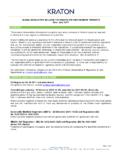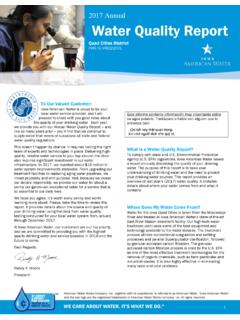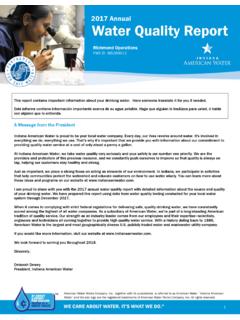Transcription of 2012 ANNUAL DRINKING WATER QUALITY …
1 Page 1 2012 ANNUAL DRINKING WATER QUALITY report CITY OF ASHEBORO WATER System Number: 02-76-010 The City of Asheboro is pleased to present the 2012 WATER QUALITY report . This report is a summary of the QUALITY of WATER provided to customers. The City s top priority has always been to ensure the WATER provided to our customers meets the highest possible standards. This has been accomplished again for 2012 , meeting or exceeding all requirements by the EPA and the state. Please review this report to verify the effort invested in maintaining these standards and providing the best WATER possible to our citizens. If you have any questions about this report or concerning your WATER , please contact Michael Rhoney, WATER Resources Director at (336) 626-1234 Ext. 2210. We want our valued customers to be informed about their WATER utility.
2 What EPA Wants You to Know DRINKING WATER , including bottled WATER , may reasonably be expected to contain at least small amounts of some contaminants. The presence of contaminants does not necessarily indicate that WATER poses a health risk. More information about contaminants and potential health effects can be obtained by calling the Environmental Protection Agency's Safe DRINKING WATER Hotline (800-426-4791). Some people may be more vulnerable to contaminants in DRINKING WATER than the general population. Immuno-compromised persons such as persons with cancer undergoing chemotherapy, persons who have undergone organ transplants, people with HIV/AIDS or other immune system disorders, some elderly, and infants can be particularly at risk from infections. These people should seek advice about DRINKING WATER from their health care providers.
3 EPA/CDC guidelines on appropriate means to lessen the risk of infection by Cryptosporidium and other microbial contaminants are available from the Safe DRINKING WATER Hotline (800-426-4791). If present, elevated levels of lead can cause serious health problems, especially for pregnant women and young children. Lead in DRINKING WATER is primarily from materials and components associated with service lines and home plumbing. The City of Asheboro is responsible for providing high QUALITY DRINKING WATER , but cannot control the variety of materials used in plumbing components. When your WATER has been sitting for several hours, you can minimize the potential for lead exposure by flushing your tap for 30 seconds to 2 minutes before using WATER for DRINKING or cooking. If you are concerned about lead in your WATER , you may wish to have your WATER tested.
4 Information on lead in DRINKING WATER , testing methods, and steps you can take to minimize exposure is available from the Safe DRINKING WATER Hotline or at The sources of DRINKING WATER (both tap WATER and bottled WATER ) include rivers, lakes, streams, ponds, reservoirs, springs, and wells. As WATER travels over the surface of the land or through the ground, it dissolves naturally-occurring minerals and, in some cases, radioactive material, and can pick up substances resulting from the presence of animals or from human activity. Contaminants that may be present in source WATER include microbial contaminants, such as viruses and bacteria, which may come from sewage treatment plants, septic systems, agricultural livestock operations, and wildlife; inorganic contaminants, such as salts and metals, which can be naturally-occurring or result from urban stormwater runoff, industrial or domestic wastewater discharges, oil and gas production, mining, or farming; pesticides and herbicides, which may come from a variety of sources such as agriculture, urban stormwater runoff, and residential uses; organic chemical contaminants, including synthetic and volatile organic chemicals, which are by-products of industrial processes and petroleum production, and can also come from gas stations, urban stormwater runoff, and septic systems.
5 And radioactive contaminants, which can be naturally-occurring or be the result of oil and gas production and mining activities. In order to ensure that tap WATER is safe to drink, EPA prescribes regulations which limit the amount of certain contaminants in WATER provided by public WATER systems. FDA regulations establish limits for contaminants in bottled WATER , which must provide the same protection for public health. Page 2 When You Turn on Your Tap, Consider the Source The City of Asheboro has four raw surface WATER (untreated) reservoirs: Lake McCrary and Lake Bunch (1073 Little Lakes Trail); Lake Lucas (3158 Old Lexington Road); and Lake Reese (4850 Jackson Creek Road). Surface WATER is transferred from our lakes by electrically powered pumps to the W. L. Brown, Jr. WATER Plant (1462 Winslow Avenue). The WATER facility uses conventional WATER treatment processes to produce up to 12 million gallons of WATER per day.
6 The City WATER Plant treated an average of MGD for calendar year 2012 . CUSTOMER VIEWS WELCOME If you are interested in learning more about the WATER treatment process and WATER QUALITY or participating in the decision-making process, there are opportunities available. Questions regarding WATER QUALITY can be answered by calling the WATER Treatment Plant staff at 626-1215. The Asheboro City Council meets at 7:00 on Thursday following the first Monday of each month at City Hall, 146 N. Church Street. Council meetings are open to the public. Source WATER Assessment Program (SWAP) Results The North Carolina Department of Environment and Natural Resources (DENR), Public WATER Supply (PWS) Section, Source WATER Assessment Program (SWAP) conducted assessments for all DRINKING WATER sources across North Carolina. The purpose of the assessments was to determine the susceptibility of each DRINKING WATER source (well or surface WATER intake) to Potential Contaminant Sources (PCSs).
7 The results of the assessment are available in SWAP Assessment Reports that include maps, background information and a relative susceptibility rating of Higher, Moderate or Lower. The relative susceptibility rating of each source for the City of Asheboro was determined by combining the contaminant rating (number and location of PCSs within the assessment area) and the inherent vulnerability rating ( , characteristics or existing conditions of the well or watershed and its delineated assessment area). The assessment findings are summarized in the table below: Susceptibility of Sources to Potential Contaminant Sources (PCSs) Source Name Susceptibility Rating SWAP report Date Lake Reese Higher February 19, 2010 Lake Bunch Moderate February 19, 2010 Lake Lucas Moderate February 19, 2010 The complete SWAP Assessment report for the City of Asheboro may be viewed on the Web at: Note that because SWAP results and reports are periodically updated by the PWS Section, the results available on this web site may differ from the results that were available at the time this CCR was prepared.
8 If you are unable to access your SWAP report on the web, you may mail a written request for a printed copy to: Source WATER Assessment Program report Request, 1634 Mail Service Center, Raleigh, NC 27699-1634, or email requests to Please indicate your system name, number, and provide your name, mailing address and phone number. If you have any questions about the SWAP report please contact the Source WATER Assessment staff by phone at 919-707-9098. This report is available for review by calling the Director of WATER Resources at (336) 626-1234 Ext. 2210. It is important to understand that a susceptibility rating of higher does not imply poor WATER QUALITY , only the system s potential to become contaminated by PCSs in the assessment area. WATER QUALITY Data Tables of Detected Contaminants The City of Asheboro s WATER Treatment Plant, PWS ID No.
9 02-76-010, is required to test for over 80 constituents to make sure that the WATER you drink is safe. We are pleased to report that for the calendar year 2012 , the WATER delivered to your homes and businesses complied with all state and federal requirements. The following regulated constituents were detected in our finished DRINKING WATER as analyzed between January 1 and December 31, 2012 . Finished WATER is the WATER that leaves our treatment plant and is distributed throughout the system. Important DRINKING WATER Definitions: Not-Applicable (N/A) Information not applicable/not required for that particular WATER system or for that particular rule. Parts per million (ppm) or Milligrams per liter (mg/L) - One part per million corresponds to one minute in two years or a single penny in $10,000. Parts per billion (ppb) or Micrograms per liter (ug/L) - One part per billion corresponds to one minute in 2,000 years, or a single penny in $10,000,000.
10 Nephelometric Turbidity Unit (NTU) - Nephelometric turbidity unit is a measure of the clarity of WATER . Turbidity in excess of 5 NTU is just noticeable to the average person. Action Level (AL) - The concentration of a contaminant which, if exceeded, triggers treatment or other requirements which a WATER system must follow. Treatment Technique (TT) - A required process intended to reduce the level of a contaminant in DRINKING WATER . Page 3 Maximum Residual Disinfection Level Goal (MRDLG) The level of a DRINKING WATER disinfectant below which there is no known or expected risk to health. MRDLGs do not reflect the benefits of the use of disinfectants to control microbial contaminants. Maximum Residual Disinfection Level (MRDL) The highest level of a disinfectant allowed in DRINKING WATER . There is convincing evidence that addition of a disinfectant is necessary for control of microbial contaminants.




